Justin Smoak’s career has really been a wild ride. From being a failed first-round draft pick and top prospect with the Texas Rangers and the Seattle Mariners, to having a late-career resurgence with a .270/.355/.529, 38 home run season with the Toronto Blue Jays in 2017, to slowly crashing back to Earth last year and this year, it’s been … interesting to say the least.
But this year, Smoak has been really bad. Last year, he wasn’t what happened in 2017, but he was usable. A .242 average and especially a .350 OBP with 25 home runs and a .216 ISO is a fairly useful player in most fantasy leagues, especially deep ones and OBP ones.
That hasn’t been the case this year. Smoak is unownable in non-OBP formats, slashing .222/.355/.430 so far this year, as of this writing, so it’s not really a surprise that he’s only owned in 39% of leagues as of now.
But a closer look into Smoak’s stats reveal something fascinating—Smoak should be hitting a lot better, and as a result, he could be due for a second-half resurgence.
Why Smoak Should Be Better
A first look at Smoak’s stats on the year and you may be quick to dismiss his 2017 as a flash in the pan and his subsequent 2018 season and this season so far to be the logical decline of a hitter who wasn’t all that special in the first place.
But when you look deeper at Smoak’s numbers, you’ll notice a few things.
First of all, he’s not hitting the ball all that differently:
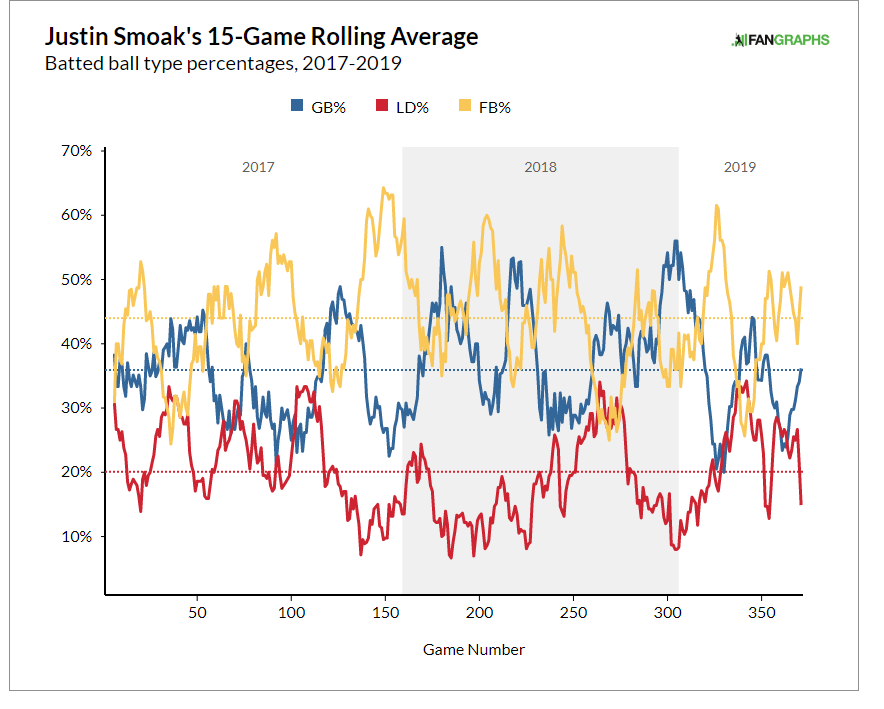
In fact, if anything, he’s hitting the ball pretty well. His line-drive rate sits at 21.7%, better than 2018 (17.9%) and 2017 (21.2%); his ground-ball rate sits at 32.8%, again better than 2018 (39.5%) and 2017 (34.3%); and his fly-ball rate sits at 45.6%, better than, you guessed it, 2018 (42.6%) and 2017 (44.5%).
Those differences aren’t night and day, but that’s kind of the point. Why is he playing like hot garbage if his quality of contact isn’t all that different?
What about his plate discipline? Well, that’s been pretty great too:
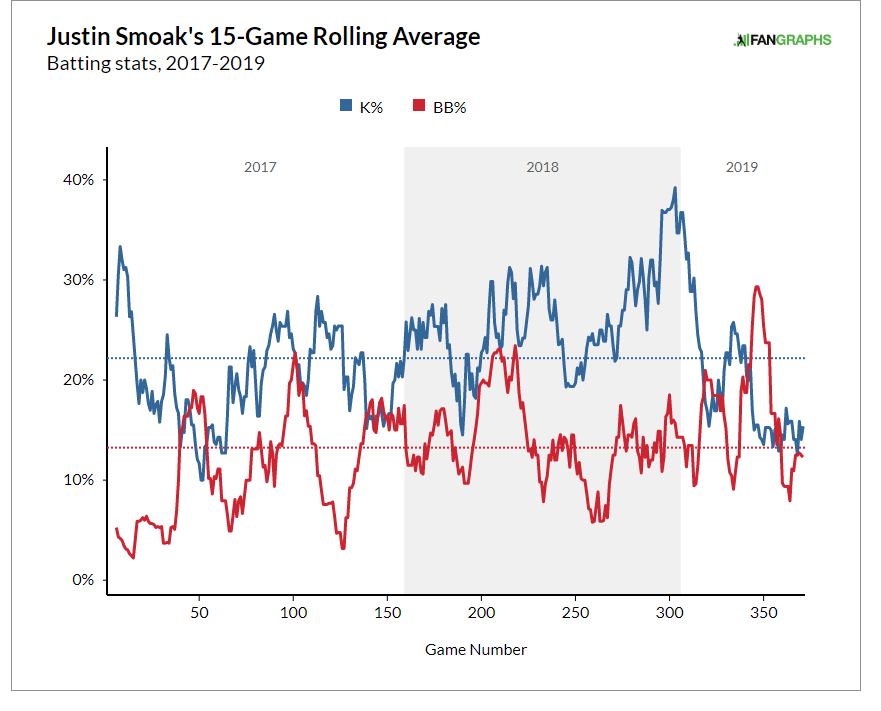
He’s still walking a ton, with a beautiful 15.8% walk rate so far (a career-best), and his strikeout rate is sitting at a nice 18.3% (also a career-best). That’s not to mention the fact that his chase rate is at a career-best 21.9%, and his swinging-strike rate is also at a career-best 8%.
I think all of this together explains what’s perhaps the most interesting thing about Smoak’s season so far—the difference between his actual stats and his expected stats. Take a look at his xwOBA over the past few years:
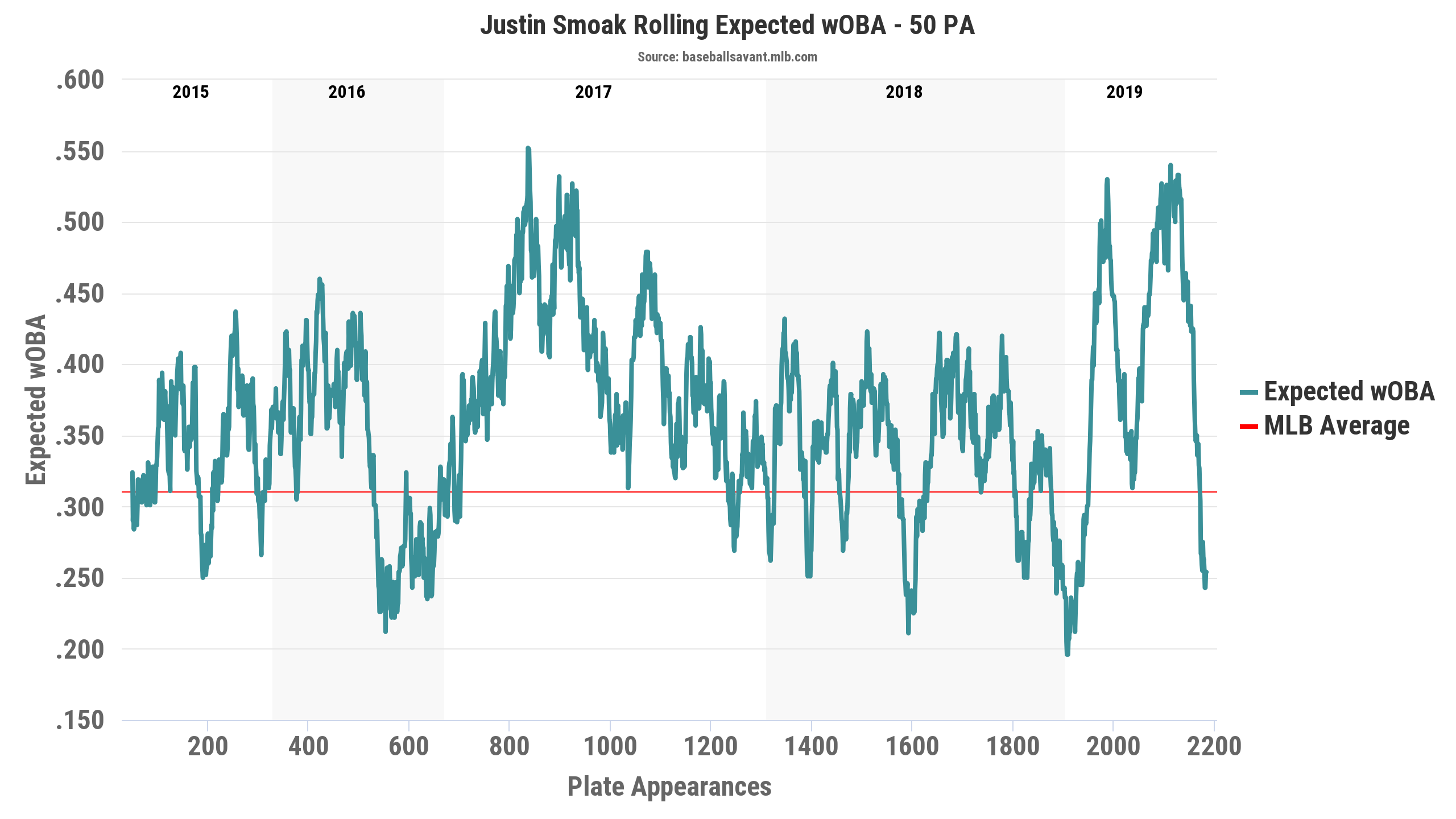
Now take a look at his xSLG:
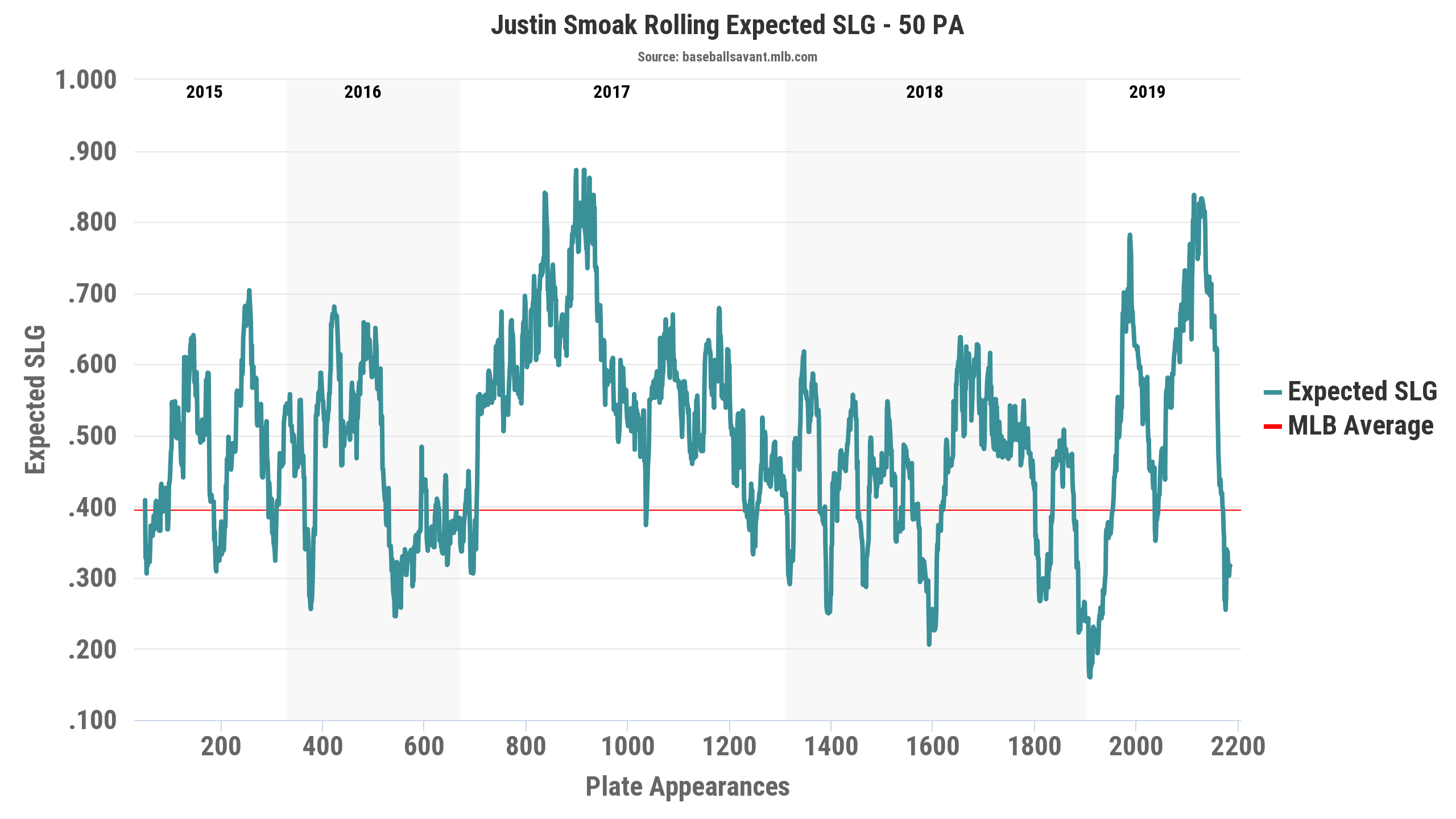
What do you notice? Both graphs show his xwOBA and his xSLG are pretty great and pretty in line with his breakout 2017 season. His xwOBA is good for top 5% in baseball, and his xSLG is good for top 6%. But the gaps between his actual stats and his expected stats are pretty significant.
| AVG | wOBA | SLG | |
| Actual | .222 | .342 | .430 |
| Expected | .268 | .398 | .537 |
That .056-point gap between his wOBA and xwOBA? That’s good for the fourth-biggest in baseball. And the .107-point gap between his slugging and xSLG? That’s also good for the fourth-biggest in baseball.
So What’s Wrong With Him?
So if Smoak has these massive gaps between his actual season numbers and his expected Statcast numbers, then has he just been getting unlucky? What’s going on?
I think bad luck is definitely a large part of it, as his .223 BABIP would attest. But a large portion of what’s been going on with Smoak is where he’s hitting the ball.
We’ve already established that Smoak is hitting fewer ground balls, so that’s not the problem. The problem is the fly balls. If your first instinct when you read that was to say, “Oh, well what’s his HR/FB rate?” I want you to know that I’m proud of you and you’re wonderful. However, that’s not the answer, as his HR/FB rate is sitting at 17.1%, in line with the past couple years.
So roughly the same proportion of his fly balls are becoming home runs (which makes sense given his still-excellent .209 ISO), but a much lower proportion of his fly balls are becoming hits. Why is that?
It’s because of where he’s hitting those fly balls.
This is a heat map of where all non-ground-ball batted-ball events ended up for Smoak in 2018:
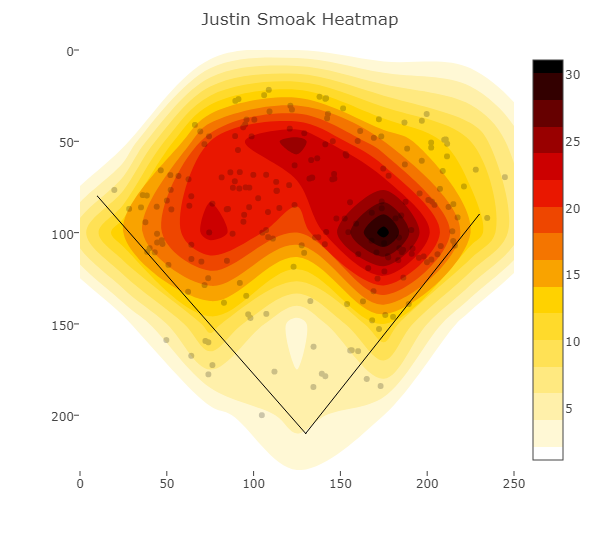
It’s important to remember Smoak is a switch hitter, so this heat map shows a lot of pulled balls (mostly to right field because he bats as a lefty more often than not). Pulled balls are good for power.
Now, take a look at his heat map on all non-ground balls this year:

Now look, I’m not a Major League baseball player, but I’d take a wild guess and say that straightaway center field is not exactly the ideal place for you to hit balls in the outfield.
It should be no surprise, then, after looking at those heat maps, that Smoak’s rate of balls hit to center field is at a career-high 37.2%. Now, his pull rate is still pretty decent; he’s not launching everything to center field, and that explains why he’s still getting good power. But the fact that he’s hitting so many fly balls to center field could help explain his low BABIP and his horribly low average.
It also helps explain the gap between his actual stats and his expected stats, especially when you see that he’s still hitting the ball pretty hard, with a 12.8% barrel rate (tied for second-best of his career) and a 43.9% Baseball Info Solutions hard-hit rate (a career-best).
Conclusion
So is Smoak going to continue to be bad, or will this correct itself? I lean toward the latter based on his quality of contact stats and his expected stats. This will level out, I believe, and I could see Smoak having himself a pretty good second half.
I don’t believe there’s something Smoak is doing wrong in his approach that will lead him to continue to hit so many balls to center field. I don’t think that’s necessarily something he can control that well, and as a result, I don’t know that there’s really any adjustment he needs to make.
With the way Smoak is hitting the ball, his stats should normalize with some positive regression. In OBP leagues, he’s still absolutely worth owning thanks to that awesome walk rate and his good power. But in standard leagues, I could see him being very useful in the second half of the season.
So my recommendation for right now? He’s available in 61% of leagues, and I think you should do one of two things: If you’ve got an open bench spot on your roster that you can burn, go ahead and pick him up and let him ride your bench until he heats up.
If not, then pay very close attention to him, and once he starts to heat up, go ahead and pick him up. Based on how he’s played so far this year and the moderate disappointment he was last year compared with his breakout, I don’t think Smoak is going to be at risk of being snatched off the waiver wire until he starts to heat up.
But pay attention to him because I do think a hot streak is going to be coming in the second half. I still think he’s got 30-ish home run power, and if that average can start creeping up, he’ll be a pretty useful fantasy asset.
Photo by Gerry Angus/Icon Sportswire


That first graph looks like a child’s rendition of Badlands National Park. ;-)